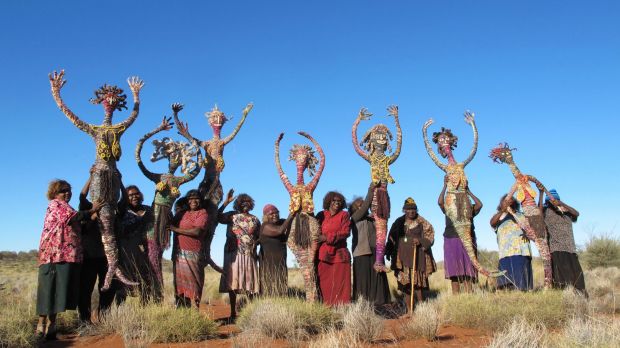Art reviewSonglines: Tracking the Seven SistersNational Museum of AustraliaCloses February 25, 2018, daily 9am – 5pm
It is almost impossible to translate concepts involved in Australian Indigenous culture to a contemporary non-Indigenous audience. It is not only a question of language, but also the entire intellectual frame of reference, where concepts that are central to Indigenous culture have no equivalent in Western thought.

The concept of Songlines is a prime example where, to describe them as epic Indigenous tales, could bring to mind Homer, which is somewhat beside the point. This immediately brings to the fore the concept of Tjukurpa, that in the past has been described as a Dreaming or Dream-time myth, and this is another conceptual stumbling block. The ancestral beings travelled throughout the continent creating the landscape forms along the way and leaving in their wake rites and rituals that needed to be observed for the universal order to continue.
In more closely-related cultures, for example, that of ancient Greece, the usual strategy was to learn the language so that one could at least read the texts in the original and gain a greater understanding of key untranslatable concepts. Few non-Indigenous Australians have mastered even a single Aboriginal or Torres Strait Islander language to follow oral traditions in the original tongue, and even among curators of Indigenous art in Australian museums, in my experience, fluency in one of the 150 Aboriginal languages is not common.

Faced with something that is largely incomprehensible to most people, the National Museum of Australia in its Songlines: Tracking the Seven Sisters exhibition has embarked on an ambitious holistic strategy. Rather than opt for a museum display of assembled objects that illustrate a theme, accompanied by wall text captions, they have employed several new technologies to recreate the experience of this Tjukurpa for the visitor.
The Seven Sisters Tjukurpa is one of the grand ancestral creation tales that moves across many Aboriginal nations and language groups, including the Martu, Ngaanyatjarra, Pitjantjatjara and Yankunytjatjara lands. The narrative deals with a group of female ancestral beings who travel across central Australia pursued by a powerful ancestral shape-shifter, known as Wati Nyiru, or Yurla, who can adopt many forms to confuse the Seven Sisters, including becoming the wind, food, shade or a snake. During this endless journey of pursuit, the women and their lustful male shape-shifter pursuer, create and give name to many sacred sites. They are also imprinted on the heavens in the transit of the Orion constellation and the Pleiades star cluster.
As you enter the exhibition you are introduced to the Seven Sisters themselves woven human-size by the remarkable Tjanpi Desert Weavers. (These are the same weavers who collaborated with Fiona Hall for the 2015 Venice Biennale.) Then we are invited to follow the journeys and creation stories associated with the Seven Sisters that at each site are marked with paintings and objects. Some of these are quite stunning, such as the Kungkarrangkalpa Tjukurrpa (2015), a collective painting by a group of artists, and the various carved wooden objects and ceramics, while others are somewhat ordinary, but accurately preserve the sacred iconography.
The beauty of the exhibition is that it takes you visually on the journey as you travel from country to country, site to site, exploring the five Indigenous Western Desert Songlines and, where possible, the tangible physicality of the experience is shared with the viewer. Immersive digital installations, audio with chant and songs, add to the sense of the actuality of the experience. The spatial and geographical aspect of the exhibition is more important than simply the collection of beautiful objects and the desire here is to produce the illusion of travelling with the ancestral beings. Although many of these strategies had already been attempted in the very successful Yiwarra Kuju: The Canning Stock Route exhibition, there is one here that is unique to this show.

The DomeLab is something that seems to belong more to a James Turrell exhibition than a museum display dealing with Aboriginal art. It is a large six-metre-wide dome that in very crisp, high definition digital imagery replicates the remote Cave Hill site in South Australia with its ancient rock art. This is juxtaposed with the "Travelling Kungkarangkalpa", where the grass figures of the Seven Sisters are cast into the skies forming the transit of the Orion constellation and the Pleiades star cluster.
You are invited to lie down under this whirling dome (there is provision for about 30 people at a time) and to become completely immersed in travelling with the Seven Sisters. The resolution of the imagery is crystalline so that the perception of being there and witnessing the journey becomes palpable.

Towards the conclusion of the exhibition, on life-size screens, elders speak in language, with subtitles underneath, explaining the universal significance of this Tjukurpa and the need to preserve it for future generations.
Songlines: Tracking the Seven Sisters acknowledges the responsibility that Australian museums have to preserve, explain and celebrate Indigenous culture. It is a bold and beautiful exhibition where the Indigenous voice is loud and clearly articulated and not drowned out by those of anthropologists and antiquated museum practices. It sets a new benchmark in presenting Aboriginal art in a museum exhibition.